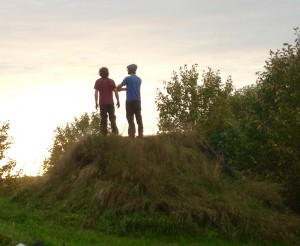Just outside Selfoss–a town of 6,500 (quite big for Iceland)–the CELL group visited a home and museum, built, owned and run by a vivacious couple in their 60s. Kristine was a biochemist for most of her life, and Hannes an artist, self-taught architect, builder, and writer. He makes his own tools and is quite the historian as well. The two of them invited us into their home with an energy so vibrant and kind, that I wanted to give them warm hugs and hear their life stories before we sat down for coffee! Hannes is the last person in Iceland with extensive knowledge on traditional Icelandic turf houses and farms, and he’s almost finished writing a book to preserve this valuable information. Before the post-WWII modernization of Iceland, and Reykjavik (currently 120,000 of the 320,000 people in Iceland) in particular, a large portion of the nation lived in turf houses. Turf houses are clusters of small structures that have foundations comprised of large stones layered with turf (a material dense with webs of roots, soil, and grass). These layers are stacked up and act as insulation and structural support between and around each building. These turf houses seem to be growing out of the earth and are often partially underground with a hill-like grassy roof. Hannes explained that the beauty of these traditional structures exists in their asymmetry and natural appearance, integrated into, instead of protruding from, the landscape.
Hannes and Kristine renovated a traditional turf house complex that used to act as a farm, and use it as an educational exhibit as well as a place for guests to stay. Across a grassy field, the two of them constructed their house and attached museum by hand, creating a gorgeous modern structure that integrates traditional turf house construction principles. The interior is decorated with beautiful images of turf houses, various paintings, and dozens of sculptures hand-made by Hannes. The stunningly beautiful floor consisted of mostly reclaimed granite chunks arranged into a sparkling mosaic. All of the granite was obtained for free by this resourceful couple instead of being dumped, wastefully into the ocean. Lush green vines hung from the array of windows onto a colorful arrangement of potted plants and flowers. Kristine made sure we never went hungry with her scrumptious cooking, and I was awe-struck by the incredible combination of their accomplishments and warm-hearted, kind nature. They seemed delightfully happy and occupied with things they enjoy, and I was inspired to hopefully shape my own future as happily as they seem to have made theirs. I was warmed by Kristine’s welcoming exuberance and incredible life-stories. Hannes’ eccentric presentation style and in-depth and well-rounded knowledge gave the strong impression that he has a deep, intuitive artistic and physical understanding of the world around him.
We worked with Hannes to begin the excavation and reconstruction of another turf house that had been lost in the earth decades ago. We helped move gigantic foundation stones and rolled, wiggled, and dug them into precise place to begin reorganizing the foundation of this lost treasure. This was both exhausting and exciting work that we felt lucky to be a part of! That night, after an incredible dinner cooked by Kristine and many educational discussions with Hannes, the 12 CELL students slept in the main living portion of the turf house. Before departing the following afternoon, we worked more on the new foundation, continually impressed with Hannes’ patience with us and Kristine’s incredible, mandatory home-cooked snack breaks. We were all moved by our two days with Hannes and Kristine and were sad to say goodbye. We’re incredibly fortunate to have met such special people during our experiences here in Iceland.
By Jason Brody
